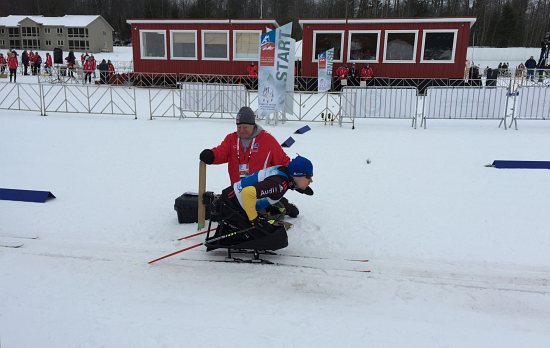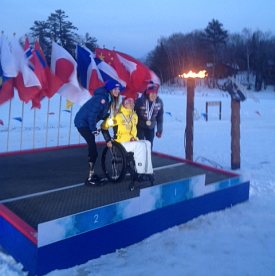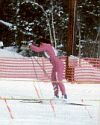IPC Nordic Skiing World Championships Wrapup
Failure will never overtake me if my determination to succeed is strong enough.
~Og Mandino
Anyone who has ever competed in a cross country ski race can appreciate how difficult of a sport it is to master. It is both physically demanding, requiring the use of almost every muscle in your body to maintain a fast pace even while climbing up steep hills, and technically challenging. Each race course has its share of fast descents that often end in a sharp turn, which must be cornered at a high speed while surrounded tightly by your fellow competitors. In addition to the physical and technical challenges of cross country skiing, it is also an outdoor winter sport which means that it will often be cold out during the race, not to mention the possibility of having to deal with wind, snow, sleet, rain or anything else that Mother Nature can throw at you.

The really good skiers practice what is called ‘transitions’, the technical adjustments that are needed to adapt to directional and gradient changes in the course, so not to lose any speed. Although mastering transitions makes sense in theory, in practice, when you are actually skiing on a ‘major league’ course like the Birkie or Telemark, you are often just concerned about the snow directly under your feet and trying to stay on the trail and less concerned about accelerating around a fast corner.
Having a great deal of appreciation for the art of ski transitions, I would never have believed it possible that a visually impaired skier racing at top speed could maintain perfect form around a crazy tight corner, and then without a moment’s pause, launch into the V2 technique to accelerate up a steep hill relying only on feel of the snow underneath his feet and the cadence of a sight guide a few yards ahead.
This past week I was witness to the IPC World Championships up in Cable, WI. I saw first-hand a competitive group of skiers participating in numerous races on an extremely challenging course, mastering the transitions from fast descents to sharp corners, to steep climbs, and every other challenge possible on a trail that traverses those many undulations left behind from glacial activity thousands of years ago on an esker now known as Mount Telemark.
With so many individual events scheduled over a nine day period, there was little time for the athletes to get any rest or recover. US sit-skier Andy Soule had already participated in numerous events of various lengths for both cross country and the biathlon when he raced in the penultimate event of the competition – the mixed relay. Because the US team had only one standing skier, Andy was forced to ski on the most difficult course, using only his upper body to propel himself up the steepest hill on the trail. There is a video linked to the IPC Nordic facebook site of Andy skiing that section which is a must watch!
The final event of the competition was the open relay. The French team led by their anchor, visually impaired skier Thomas “ToTo” Clarion, defeated the defending Olympic gold medal Russian team in a dramatic upset. My wife Ann and I had spent some time getting to know the French team and their coaches, which made this victory all the more exciting to us. They were a dedicated and likable group of young men who were totally elated and humbled by their surprising victory.
US team members Omar Bermejo and Bryan Price shared with us some the trials and tribulations that befall an athlete training for the Nordic Paralympics. Like any serious skier, they have to come up with innovative ways of training on dry land. Omar said he had his share of falls and plenty of strange looks when he trained in and around the mountains of Tucson, AZ. Bryan admitted he once crashed into US visually impaired skier Kevin Burton. Bryan said that crashes are no problem; he is just adding more scars on top of the scar tissue he already had from the military. They both brought their families with them for the first weekend of competition, including Bryan’s loving young daughter, Ashlynn. Both of these young men are relatively new to skiing, but they are committed to success and will someday stand on the medal podium.
In my first post I didn’t draw any attention to the biathlon events. If cross country skiing is tough, biathlon is even tougher. You have to ski out on the same course used for the cross country events, and then when you return to the stadium, you have to relax and concentrate while getting into a prone position to shoot five 15 mm targets at a distance of 10 meters. Every miss requires a 100 or 150 meter penalty lap depending on whether the athlete is sitting or standing. The visually impaired skiers have their biathlon competition as well. The skiers with some visual sense must wear a pair of opaque glasses to block out any light. The skier puts on a pair of head phones which receive a signal from the rifle that changes frequency as the rifle aim gets closer or further from the target. Visually impaired skier Olga Prylutska of the Ukraine hit 35 out of 35 in her biathlon events!
 Overall, the US team had a great World Championship with Andy Soule winning a total of five medals and Oksana Masters winning two; this achievement adding to her already impressive resume winning medals in both the winter and summer Paralympic games. Particularly dominant in the Games were the Russians and the Ukrainians. Multi gold medalist Russian athlete Roman Petushkov looks like he was cut out of granite. Fellow Russian athlete Aliaksandr Davidovich looks like he was the one who carved Petushkov out of granite – with his bare hands.
Overall, the US team had a great World Championship with Andy Soule winning a total of five medals and Oksana Masters winning two; this achievement adding to her already impressive resume winning medals in both the winter and summer Paralympic games. Particularly dominant in the Games were the Russians and the Ukrainians. Multi gold medalist Russian athlete Roman Petushkov looks like he was cut out of granite. Fellow Russian athlete Aliaksandr Davidovich looks like he was the one who carved Petushkov out of granite – with his bare hands.
Throughout the event I was collecting athlete and coach’s autographs on a Championship poster given out by the Cable Chamber of Commerce. I thought it was fitting that the last person to sign my poster was the star of the Games, Ukrainian skier Oleksandra Kononova, winner of 6 individual gold medals. Oleksandra developed a condition as a child which resulted in one of her arms not developing properly. Also orphaned as a child, she was raised alone by her grandmother. Because of her condition she was picked on and bullied by other kids throughout her childhood. One day, while playing in a park, she noticed some athletes on roller skis which got her attention. She asked about joining them and eventually developed into an accomplished skier winning numerous competitions, and ultimately being named 2010’s Ukraine sportsperson of the year! She is a national hero. That is the definition of determination!
There were many people involved planning, preparing, and operating who spent countless hours making the 2015 Paralympics World Championships happen. Although my personal involvement and contributions were relatively small, the competition affected me in such a positive way that it is beyond my writing ability to describe. I can only imagine the impact it has had on the many people who interacted with the athletes on a daily or even an hourly basis. Any person who was involved in the event has had to have been touched in a positive way.
Congratulations to Cable, CXC, the hundreds of volunteers, the staff, the coaches, and all the athletes who made this competition such a meaningful event!
I can’t wait until they come back!

